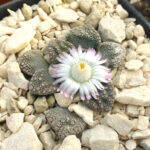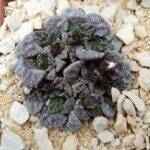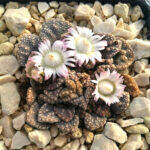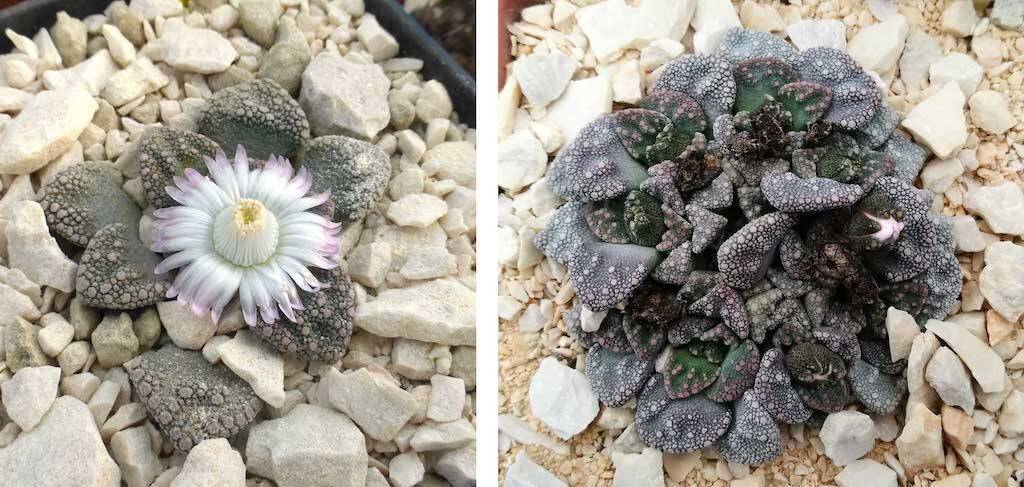From mid-December to the beginning of January is the flowering time for a rather widespread and highly appreciated succulent plant from an aesthetic point of view: Titanopsis calcarea. The appearance of the leaves, their arrangement, the color and the punctiform reliefs (similar to warts) on the fleshy surface of the leaves themselves make this plant a small living rock, on a par with the Lithops. And it is no coincidence that the name Titanopsis derives from the union of the Greek terms “titanos” (understood as “gypsum”, “lime”) and “opsis“, i.e. “appearance”. In short, a plant with the appearance of a calcareous rock or a “clump of earth” (the effective definition is by Giuseppe Lodi), we could define it. The Titanopsis genus belongs to the Aizoaceae family (formerly Mesembriantemaceae) and is native to Southern Africa, in particular Namibia and the Cape Province. The cultivation of these plants, and specifically of Titanopsis calcarea, requires some special precautions compared to those we reserve for cacti.
Let’s go into detail and get to know this plant and its needs better in the following article (….).
Introduction
As is often the case with plants, the classification of species included in the Titanopsis genus is debated and depending on the author/researcher, Titanopsis species can range from three to six. On the other hand, taxonomy is a complex and constantly evolving matter, as I have highlighted in a specific article that you can find at this link.
Description

Limiting ourselves to the “calcareous” species of the genus Titanopsis, we can first of all say that this Mesembriantemacea is easily identifiable even by the less expert eye: the stem is made up of groups of leaves up to 5-6 centimeters wide, which depart from the center and end with the apex rounded, spatulate, arrowhead. The surface of the leaves, especially the apical part, is covered by point-like reliefs similar to warts, which contribute to giving the plant that “lumpy”, rock-like appearance. The color decisively contributes to the overall result: the leaves in fact have a color ranging from blue to greyish (with a tendency to darken and redden if exposed to direct sunlight), with the reliefs of a lighter colour, gray to reddish.
Cultivation
Regarding the cultivation of this particular succulent, I have often found, both online and in various books, approximate or conflicting indications. The controversial element is that relating to irrigation: some sources advise treating this plant like a cacti, thus suggesting that it be watered only from spring to the beginning of autumn; other authors suggest a similar approach to the one recommended for Lithops, i.e. watering from May onwards, suspending it in the summer months and resuming it moderately in autumn.

In the past years, struggling to extricate myself from conflicting indications, I decided to carefully observe my Titanopsis calcarea to try to understand in which months the plants vegetated and in which they went dormant (at least in the Northern hemisphere), so as to adjust the watering accordingly. For a year I therefore almost completely suspended the irrigations, letting the plants “talk” with growth, flowering, color change, etc. For several years now, on the basis of my observation, I have therefore adopted a specific watering regime for the Titanopsis: I water in moderation, reducing the watering to once a month, from January to the end of April. With the arrival of spring and the first heat, I suspend irrigation because I have noticed that these plants begin to slow down the vegetation until it stops completely in summer: the stems deflate and the leaves retract until the plant slightly sinks. I start watering again, always in moderation and sporadically, only when the heat lets go, around October and until the end of November. In the autumn period I noticed that Titanopsis calcarea resumes vigorously vegetating, swelling the stem until it “re-emerges” from the ground, putting on new leaves and, later on, starting to prepare the buds (from the end of November).
Regarding the substrate, the sources are generally less conflicting and my own experience has taught me that these plants want a very poor soil, almost completely devoid of organic matter (peat or humus). For several years I have kept my Titanopsis calcarea in a mix based on clayey field earth with little or no limestone (about 20% of the total), sand, pumice (at least 40%), quartzite and gravel. I add just 10% earthworm humus to the substrate to make the soil a minimum of nutrients, also considering that I don’t fertilize these plants. On the surface I place fragments of white limestone, which over time and with watering turn yellowish, harmonizing perfectly with the plants from a chromatic / aesthetic point of view.
In terms of exposure, the Titanopsis like full light, but I have never placed my specimens in direct sun, limiting myself to keeping them in an unshaded greenhouse, protected only by the transparent sheet of the roof.
Finally, the temperatures. Also in this case I noticed a discrepancy between the sources, with some authors recommending not to keep the Titanopsis at temperatures below 10 degrees. Also in this case, I have directly experienced and for at least seven years I have kept my Titanopsis calcarea at minimum winter temperatures close to zero, with some sporadic peaks below zero. It is essential that the temperature rises during the day, so as to keep the plants in force, which I also water in the cold months, as I wrote, albeit sparingly.
On the whole, by observing these few precautions, I can consider the Titanopsis calcarea a succulent of easy cultivation, although with a relatively slow growth, as demonstrated by the photos side by side on the cover of this article, with the same specimen photographed five years later (on the left in the 2015; on the right the same plant in 2020).
Flowering

Flowering coincides with the winter months. In my case (northern Italy) the Titanopsis calcarea flower regularly in the period between mid-December and the first half of January. The flowers, medium in size compared to the plant, emerge from the attachment of the leaves and in my specimens they are white (however, I have also seen plants with yellow flowers: I think this is the norm) with a slight pink shade at the apex of the petals. They open from rounded “calyxes”, glabrous and of the same color as the leaves.
Reproduction
The reproduction of the Titanopsis calcarea is mainly carried out by sowing, but it is also possible to multiply the plants with the method of dividing the tufts, separating the autonomous ones, ie those with their own root and which detach easily from the mother plant. I have no evidence about the multiplication by cuttings, i.e. detaching the leaves to put them to root: I have never tried and I fear it is not feasible with these plants.
SUBSCRIBE TO THE SITE – If you liked this article, subscribe to the site to have access to all the contents for one year or three months depending on the formula you choose. Here you will find terms and conditions.
SUBSCRIBE TO THE NEWSLETTER – If you want to receive the free newsletter every time new content is published (even if you have not subscribed to the site), fill in the fields at this link!
Correlated articles
Succulent plants
Cactus cultivation cards
Watering succulents
Classification of succulents
© The texts, videos, photos and graphic elaborations of the site “Il fiore tra le spine” are original material and are covered by copyright. It’s forbidden to reproduce them in any way.



